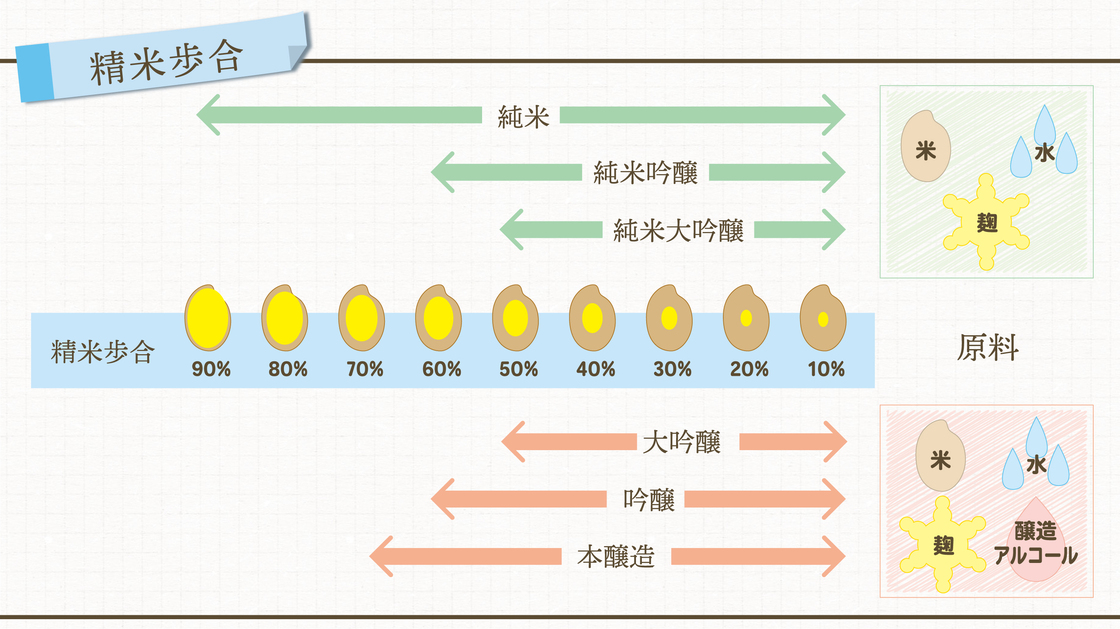I want to know the types of sake! What does Junmai and Ginjo mean? We will explain it in an easy-to-understand way!
What image comes to mind when you hear the words "sake"? Is it a drink for older men? Will I get drunk? No, it's not like that! Sake is a wonderful drink with many variations and many ways to drink it.
However, it is difficult for beginners to understand what types of sake there are and what kind of sake to choose. In this article, we will explain the "types'' of sake in an easy-to-understand manner by deciphering the information on sake labels! By understanding this, it will be easier to ask for advice at liquor stores and restaurants, and you may be able to find the sake you like more quickly. There are many ways to classify the different types of sake, such as taste and production method, but this time we will explain the most popular type, "Tokutei Meisho-shu (Specially Designated Sake)"!
Types of Sake "Tokutei Meisho-shu (Specially Designated Sake)"
You may be thinking, "I don't understand such a complicated word from the beginning..." Don't worry! Don't worry!
Even if you have never heard of this word, you must have seen or heard the words used to describe the type of sake. "Junmai Ginjo", "Daiginjo", "Honjozo", etc., which you see on sake labels and restaurant menus, are collectively called "Tokutei Meisho-shu (Specially Designated Sake)". This is a classification system based on the ingredients and production method of sake as stipulated by law (Sake Tax Law). Once you understand this classification pattern, it will be easier to understand the basics of sake types.
The classification of Tokutei Meisho-shu (Specially Designated Sake) is broadly based on two conditions: first, whether the sake is made from rice, water, and koji alone (Junmai or not / whether or not brewing alcohol is added), and second, the ratio of rice remaining after the rice used to make it (milled rice ratio). If we organize them around these two axes, we can classify them into six types as shown in the figure below. It is easier to understand when seen in an image!
(1) Whether or not the sake is made only from rice, water and koji (Junmai or not / whether brewing alcohol is added)
The first point is whether or not the sake is Junmai, i.e., whether or not brewing alcohol has been added.
Sake is brewed from rice, water, and koji, and sake made purely from rice, water, and koji without any other ingredients is literally called Junmai. On the other hand, if brewing alcohol is added, it is called "alu-ten" (meaning alcohol added), and the name is changed according to the rules.
Some may ask, "Why add brewing alcohol to Junmai?" The addition of brewing alcohol not only changes the aroma and flavor, but also makes the sake more suitable for preservation. It is also the wisdom of our ancestors that allows us to enjoy it for a long time while increasing flavor variation!
On the other hand, there are those who may not be constitutionally suited to brewed sake. For such people, choosing Junmai may allow them to enjoy sake that they have always been uncomfortable with. (My boss was also this type of person!)
(2) Percentage of rice that has been shaved off (rice polishing ratio)
The second point is "seimai-buai" (rice polishing ratio). This indicates how much of the rice used to make sake has been removed, and the percentage that remains. In other words, it is the weight of the remaining rice relative to the state of the brown rice. (Note that this is not the percentage of rice removed!)
For example, if the rice polishing ratio is 60%, the remaining white rice is 60% (the portion not used for sake brewing is 40%). The more rice that is polished, the less of it that can be used for sake making. The reason why Junmai Daiginjo and Daiginjo are more expensive than Junmai and Honjozo is due to the rice used to make them.
The reason why the rice is being shaved is to remove the proteins, fats, and other components on the surface of the rice that contribute to the unpleasant taste of sake. It is said that the more rice that is used near the center of the rice, the more the sake will be less tasteless, more aromatic, and more well-rounded in flavor.
So, is it better to shave a lot of rice? That is also not true. There is a style of sake brewing in which the rice is not milled as much, and the sake has a more subtle flavor, so it is a good idea to experiment with different styles of sake brewing.
Let's try to understand "Tokutei Meisho-shu (Specially Designation Sake)" and find your favorite flavor!
It is easy to understand the different types of sake if you keep in mind two key points: whether or not brewing alcohol is added, and the rice polishing ratio!
The table below shows a summary.
| Tokutei Meisho-shu | With or Without Brewer's Alcohol | Rice Polishing Ratio |
| Junmai Daiginjo | × | 50% or less |
| Junmai Ginjo | × | 60% or less |
| Junmai | × | Not regulated |
| Daiginjo | 〇 | 50% or less |
| Ginjo | 〇 | 60% or less |
| Houjozo | 〇 | 70% or less |
If the rice polishing ratio is 50%, sake made purely from rice, water, and koji is called "Junmai Ginjo," and if brewing alcohol is added, the sake is not made only from "Junmai," so the name changes to "ginjo". Some sake breweries intentionally change the name of their sake to "Tokubetsu Junmai" or other unique names, but it is easy to understand which of the six types of sake is made according to these two points. It is easy to understand.
If you find yourself thinking, "Hmmm? It tastes a little different from the last time I drank it...?" The difference may be due to the difference in the specific name of the sake. If you remember the combination of the brand name and the sake with the specific name, it will be easier to find the sake you like at liquor stores and izakaya (Japanese style pubs) because you can easily notice the taste and trends you prefer.
Other types of sake can be further subdivided into rice (sake rice), method of production, flavor characteristics, etc., but that will be for next time.





